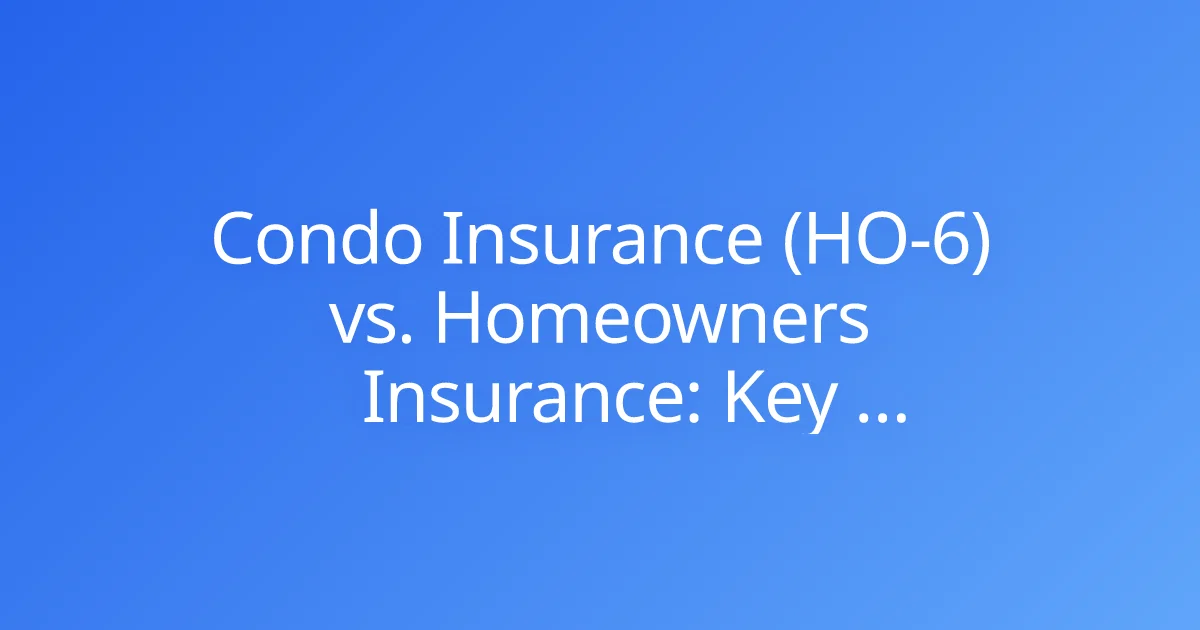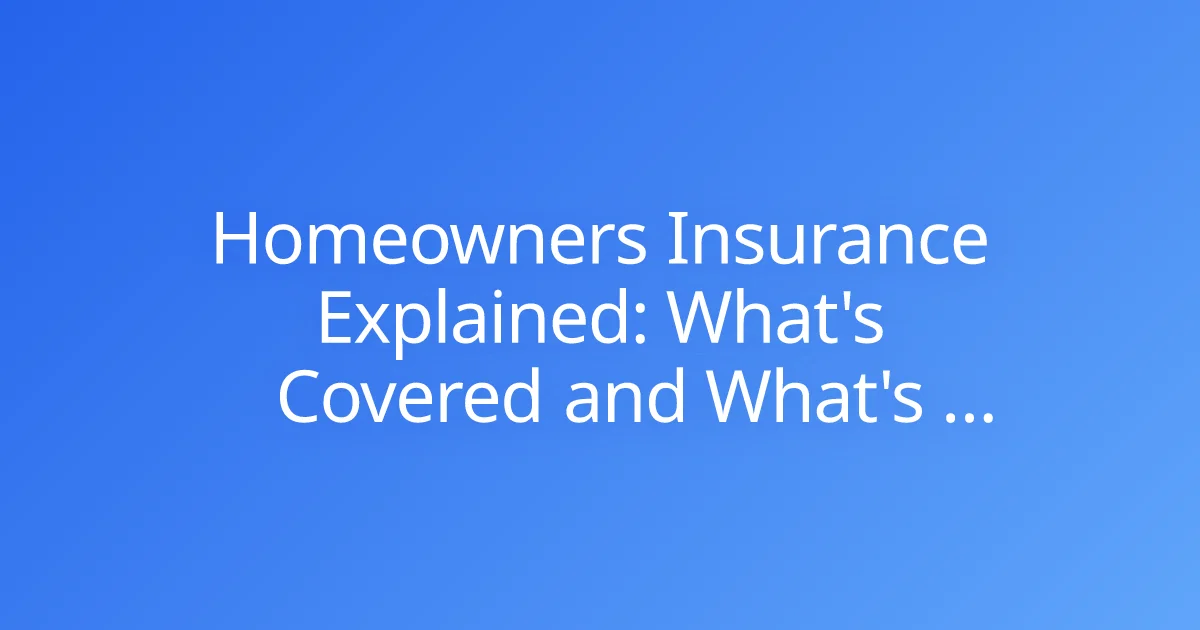Condo Insurance (HO-6) vs. Homeowners Insurance: Key Distinctions
For many, the world of insurance policies can feel like navigating a complex maze. When it comes to insuring your living space, the confusion often deepens, especially if you own a condominium. Is condo insurance (HO-6) the same as standard homeowners insurance? And if not, what are the crucial differences that could leave you vulnerable if you choose the wrong policy? Understanding these distinctions is not just an academic exercise; it's essential for ensuring you have adequate financial protection for your most valuable asset.
At The Policy Explainer, we aim to unravel these complexities. This comprehensive guide will meticulously break down the key distinctions between a typical homeowners insurance policy (HO-3) for single-family homes and a condo insurance policy (HO-6) designed specifically for condominium unit owners. We'll clarify what each policy covers, where their responsibilities diverge, and equip you with the knowledge to make an informed decision, safeguarding your investment and your peace of mind.
Understanding Standard Homeowners Insurance (HO-3)
A standard homeowners insurance policy, most commonly an HO-3 (special form), is designed for single-family homes and offers broad coverage for both the physical structure and your personal belongings.
What Homeowners Insurance Covers
An HO-3 policy typically provides comprehensive protection across several key areas:
- Dwelling Coverage (Coverage A): This protects the physical structure of your home (the house itself, attached garages, walls, roof, foundation) against a wide range of perils, except those specifically excluded (e.g., floods, earthquakes, nuclear hazard).
- Other Structures Coverage (Coverage B): This covers unattached structures on your property, such as detached garages, sheds, fences, and gazebos.
- Personal Property Coverage (Coverage C): This protects your belongings inside your home (furniture, electronics, clothing, etc.) from covered perils, both on and off your property.
- Loss of Use Coverage (Coverage D): Also known as Additional Living Expenses, this covers the costs of temporary housing, food, and other necessary expenses if your home becomes uninhabitable due to a covered loss.
- Personal Liability Coverage (Coverage E): This protects you financially if you're found legally responsible for bodily injury or property damage to another person, on or off your property. It also covers legal defense costs.
- Medical Payments to Others (Coverage F): This covers minor medical expenses for guests injured on your property, regardless of fault.
The "All-Inclusive" Nature for Single-Family Homes
For a single-family homeowner, your HO-3 policy is essentially "all-inclusive" for the structure and your contents. You own the land, the entire building, and are solely responsible for its maintenance and repair from the ground up, out to the property lines. There's no shared responsibility for external structures or common areas with other unit owners.
What is Condo Insurance (HO-6)?
Condo insurance, specifically an HO-6 policy, is a specialized form of insurance tailored to the unique ownership structure of condominiums. Unlike a standalone home, a condo unit owner typically owns only the interior of their unit, while the exterior structure and common areas are owned and managed by a Homeowners Association (HOA). This dual-ownership model necessitates a different insurance approach.
The "Walls-In" Concept
The fundamental principle behind HO-6 condo insurance is the "walls-in" concept. This means your policy typically covers what's inside your individual unit, starting from your interior walls, floors, and ceilings.
- Interior Fixtures and Improvements: This includes things like your cabinets, countertops, flooring, built-in appliances, light fixtures, and any improvements or upgrades you've made to the unit.
- Personal Property: Just like a homeowners policy, it covers your personal belongings within the unit (furniture, clothing, electronics, etc.).
- Personal Liability: It provides liability protection for accidents that occur within your unit or are caused by your actions as the unit owner, similar to an HO-3.
- Loss of Use: It covers additional living expenses if your unit becomes uninhabitable due to a covered peril.
The Role of the HOA's Master Policy
One of the most significant distinctions is the presence of an HOA's master policy. This master policy, purchased by the Homeowners Association, covers the exterior of the building, shared common areas (roof, exterior walls, hallways, lobby, gym, etc.), and the underlying structure of the complex.
- Shared Responsibility: The master policy covers the "walls-out" structure and general liability for common areas.
- Gap Coverage: Your HO-6 policy fills the gaps between the master policy and your individual unit's needs.
The Crucial Distinction: "Walls-In" vs. "Walls-Out" Coverage
The core difference between condo insurance (HO-6) and homeowners insurance lies in what each policy is responsible for covering structurally.
Homeowners Insurance: "Ground Up" Coverage
For a single-family home, your HO-3 policy covers the entire physical structure from the ground up, including the roof, foundation, exterior walls, and everything inside. You are responsible for the entire building.
Condo Insurance (HO-6): "Walls-In" and Beyond
For a condo, your HO-6 policy typically covers:
- "Walls-In" Structural Elements: This means the interior surfaces of your walls, ceilings, and floors, as well as fixtures and improvements.
- Personal Belongings: Your personal items.
- Liability: For incidents originating in your unit.
The exterior structure and common areas are covered by the HOA's master policy. However, the extent of what the master policy covers can vary significantly, which directly impacts what your HO-6 policy needs to cover.
Key Differences Summarized
Let's break down the primary distinctions across typical coverage components:
| Feature | Homeowners Insurance (HO-3) | Condo Insurance (HO-6) |
|---|---|---|
| Dwelling Coverage | Covers entire structure (house, roof, foundation, walls). | Primarily covers interior of unit (walls-in, fixtures, improvements). Master policy covers exterior. |
| Other Structures | Covers detached structures (sheds, detached garages). | Not applicable, as common areas covered by HOA master policy. |
| Personal Property | Covers personal belongings within and often away from home. | Covers personal belongings within and often away from unit. |
| Personal Liability | Covers you for bodily injury/property damage on or off premises. | Covers you for bodily injury/property damage arising from your unit/actions, often off-premises too. |
| Loss of Use | Covers additional living expenses if home is uninhabitable. | Covers additional living expenses if unit is uninhabitable. |
| Loss Assessment | Not applicable. | Crucial: Covers your share of damage or liability assessed by HOA if master policy limits are exceeded. |
| Unit Improvements | Included in dwelling coverage. | Specific coverage for upgrades you've made (e.g., custom kitchen, flooring). |
| Master Policy Role | None. | Master policy covers building exterior & common areas; defines scope of your HO-6. |
Why Understanding Your HOA Master Policy is Essential for Condo Owners
The type of master policy held by your HOA is perhaps the single most important factor influencing how much coverage your HO-6 policy needs. HOAs typically have one of three types of master policies:
1. Bare Walls-In (or Studs-Out)
- What it covers: The master policy covers only the primary structure, exterior walls, roof, and common areas. It does not cover anything within your individual unit, not even the plumbing or electrical wiring inside your walls.
- Impact on your HO-6: If your HOA has a "bare walls-in" policy, your HO-6 condo insurance needs to be very robust. You'll need substantial coverage for your interior walls, flooring, fixtures, built-in appliances, and any permanent improvements, in addition to your personal property and liability.
2. Single Entity (or Original Specifications)
- What it covers: The master policy covers the building's structure, common areas, and the original fixtures within each unit. This means it covers the "original" cabinets, standard flooring, and basic plumbing/electrical as installed when the building was built or converted.
- Impact on your HO-6: Your HO-6 policy would then need to cover your personal property, liability, and any upgrades or improvements you've made beyond the original builder-grade finishes (e.g., if you installed granite countertops or hardwood floors).
3. All-In (or All-Inclusive)
- What it covers: This is the most comprehensive master policy. It covers the building structure, common areas, and everything inside your unit, including permanent fixtures, improvements, and sometimes even wallpaper.
- Impact on your HO-6: If your HOA has an "all-in" policy, your HO-6 condo insurance can focus more heavily on your personal property and liability coverage, as many of the interior structural elements are already covered by the master policy. However, this is the rarest type of master policy.
Crucial Action: Always request and review a copy of your HOA's master insurance policy and declarations page before purchasing your HO-6 condo insurance. This will clearly outline what the HOA covers and what your individual responsibility is.
Beyond the Basics: Key Coverages in HO-6 You Might Need
While an HO-6 policy covers personal property and liability, there are two specialized coverages that are particularly vital for condo owners.
Loss Assessment Coverage
This is a critical component for condo owners. If the HOA's master policy limit is exhausted in a large loss (e.g., a massive fire damaging multiple units or a complex-wide liability claim), or if the HOA incurs a large, unexpected expense not covered by their policy (like a special assessment for a new roof after storm damage), the costs may be assessed back to individual unit owners.
- Protection: Loss assessment coverage in your HO-6 policy will cover your share of these assessments, up to your policy limit. Without it, you could be on the hook for thousands of dollars out-of-pocket.
Unit Improvements and Betterments Coverage
This coverage specifically protects the value of improvements or upgrades you've made to your individual unit beyond the original builder-grade finishes.
- Examples: If you installed custom cabinetry, high-end flooring, renovated bathrooms, or upgraded appliances, this coverage ensures those investments are protected in case of a covered loss. This is especially important with "bare walls-in" or "single entity" master policies.
Choosing the Right Coverage: Tips for Condo Owners
Making an informed decision about your condo insurance is vital for comprehensive protection.
- Obtain and Review Your HOA Documents: This is non-negotiable. Get a copy of your HOA's Covenants, Conditions & Restrictions (CC&Rs) and, most importantly, their master insurance policy and declarations page. Understand what type of master policy they have (bare walls-in, single entity, or all-in).
- Assess Your Unit's Interior Value: Factor in the cost of replacing your flooring, built-in cabinets, countertops, interior paint, light fixtures, and any upgrades you've made. This helps determine the "dwelling" coverage needed for your HO-6.
- Inventory and Value Personal Property: Create a detailed inventory of all your personal belongings. Consider replacing items at their replacement cost value (RCV) rather than actual cash value (ACV) for better protection.
- Determine Adequate Liability Limits: Consider your net worth and lifestyle when setting your personal liability limits. Many experts recommend at least $300,000 to $500,000.
- Don't Skimp on Loss Assessment Coverage: This can be a lifesaver if a major incident impacts the entire building. Discuss appropriate limits with your insurer.
- Consider an Umbrella Policy: If your net worth is substantial or you have significant assets, an umbrella policy can provide an extra layer of liability protection that kicks in after your HO-6 policy limits are exhausted.
- Consult an Insurance Professional: An experienced insurance agent or broker specializing in condo insurance can help you navigate the complexities of your HOA's master policy and customize your HO-6 policy to ensure you have no gaps in coverage.
Conclusion
While both condo insurance (HO-6) and homeowners insurance serve the fundamental purpose of protecting your property and liability, their scopes differ significantly due to the unique ownership structure of condominiums. Understanding the "walls-in" concept, the role of your HOA's master policy, and the critical importance of coverages like loss assessment and unit improvements is paramount. By taking a proactive approach to understanding these key distinctions, you can ensure your home, your belongings, and your financial future are adequately protected, providing true peace of mind as a condo owner.
Do you have more questions about how your HOA's master policy might affect your individual condo insurance needs?



